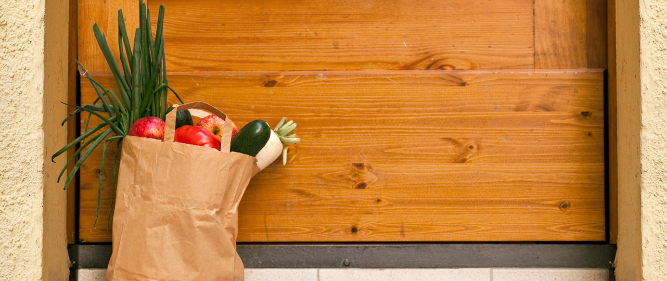In the wake of COVID-19, online grocery delivery has taken off. According to the 2020 Food Packaging & Consumer Behavior Report, 61% of survey respondents said their purchasing habits acquired during the pandemic will influence the way they shop in the future, and 51% reported using third-party grocery delivery apps within the past three months.
In light of this trend, food manufacturers may have to adapt their packaging to meet the requirements of grocery delivery. Instead of packages being stretch-wrapped onto a pallet to be unloaded by grocery store workers, they’ll be boxed and sent directly to consumers’ doorsteps.
That means outgoing packages must be sturdy enough to withstand the increased vibration and movement across a courier’s distribution chain. Some items may be shipped as is or they will have to be sent inside another shipping box padded with extra dunnage (air bags, crinkled paper, bubble wrap). Products packed in glass, cans or other rigid packaging may have to be rethought.
While it might seem like an unnecessary expense to redesign packaging, food plant operators that don’t do this will likely face skyrocketing costs from:
- Increased packaging waste
- Dunnage
- Increased corrugation used for packaging orders
Thankfully, there are a number of solutions food manufacturers can utilize to bring packaging into the e-commerce era while reducing excess costs and environmental waste.
Change the primary packaging
Updating the primary packaging to hold up to the e-commerce distribution system is the first and most obvious solution.
One format that is great for e-commerce is flexible packaging. Not only is it lightweight, which reduces shipping costs compared to heavy jars and cans, but it performs very well in the e-commerce distribution chain, while also fitting into secondary packaging more efficiently.
Food products like pastas, juice, nuts and coffee (just to name a few) can be packed in stand-up pouches and withstand the e-commerce distribution chain.
Employ active packaging design
Active packaging design involves using materials or gases to protect the integrity of the product while maintaining the freshness of the food itself. Both are used to extend shelf life.
Oxygen scavenger packs are a common form of active packaging already in use. The small packets, which usually contain powdered iron or ascorbic acid, are slipped into bags of beef jerky, dog treats and other products to help remove or decrease oxygen in the closed package.
Modified atmosphere packaging takes it a step further by filling packs with inert gases, such as nitrogen, which preserve the shelf life of the product by decreasing the amount of oxygen in a package. It can also help to delay oxidation and decrease the growth of organisms that can spoil the product.
Employ time-temperature indicators
Have you ever left meat out to thaw overnight and woke in the morning to a fully thawed cut, unsure of whether it reached temperatures that rendered it unsafe to eat?
Had the package used a time-temperature indicator (TTI), you wouldn’t have had to wonder.
For refrigerated or frozen items, a time-temperature indicator can be added to permanently display whether an item has reached a hazardous temperature. This shows consumers that proper temperature controls were in place from the time the product was packaged to the time the consumer opens the package. For example, some food should not be frozen, and a temperature indicator can reveal whether the product has been handled or stored improperly, causing it to freeze and potentially be unsafe to eat.
Additionally, an item that must be consumed within a certain number of days following its opening can use a time-temperature technology known as Timestrip, which would indicate when it should be eaten by or discarded.
Using time-temperature indicators provide added assurances to consumers who may worry about how the perishable items they ordered from a nameless, faceless entity on the internet have been treated throughout the supply chain.
Use intelligent packaging
Intelligent packaging allows customers to access even more information about their delivered items, building on the assurances time-temperature indicators provide.
Today’s health-conscious consumer not only appreciates detailed information about the source of their food, but they also like to see how many hands their items have gone through to arrive at their doorstep. This is where intelligent packaging can be of help, as it allows manufacturers to make a wealth of information available, such as:
- Shipment tracing
- Manufacturing or expiration date
- Nutritional values
- Product information
As an example of how intelligent packaging adds value, the maker of gluten-free products can use it to give customers a glimpse into the care taken in producing food for sensitive eaters.
Consumers most often access this information by scanning QR codes on the packaging, but it can also be handled using barcodes or RFID chips.
Consider increasing use of cold chain technology
Insulated containers must be kept frozen and refrigerated foods kept cold in the cargo bays and shipping trucks throughout the shipping process.
These can take the form of:
- Expanded polystyrene (EPS) molded containers
- Polyurethane containers
- Insulated envelopes
Supplemental refrigeration like ice/cold gel packs or dry ice can also be added to containers to maintain cold temperatures in shipping.
If you are thinking about redesigning your brand’s packaging to meet e-commerce demand, send me an email at foodforthought@stellar.net.



